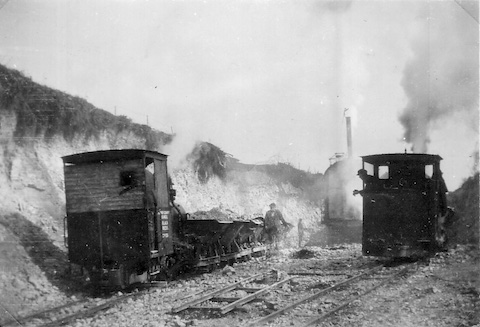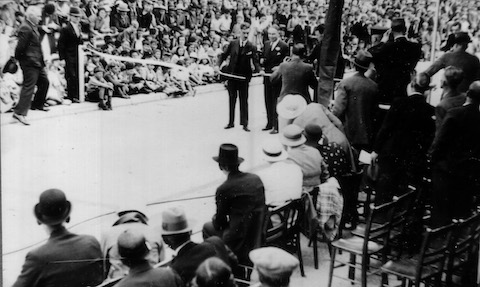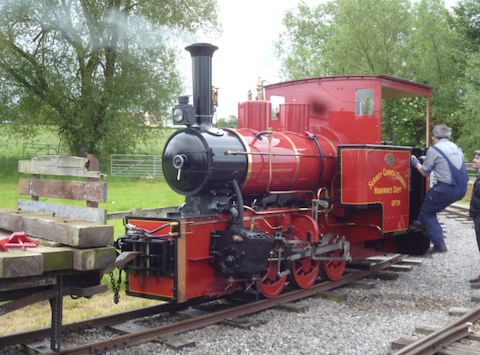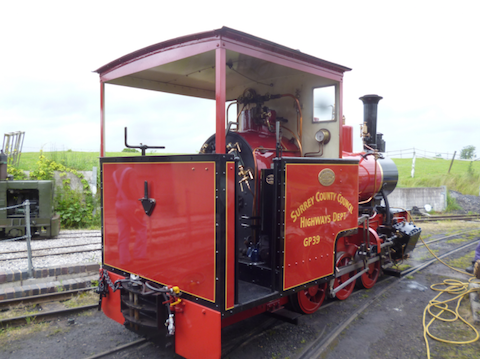- Stay Connected
 Abraham Lincoln
If given the truth, the people can be depended upon to meet any national crisis...
Abraham Lincoln
If given the truth, the people can be depended upon to meet any national crisis...
 Guildford news...
for Guildford people, brought to you by Guildford reporters - Guildford's own news service
Guildford news...
for Guildford people, brought to you by Guildford reporters - Guildford's own news service
When Steam Reigned Supreme On The Bypass
Published on: 13 Feb, 2022
Updated on: 15 Feb, 2022
By David Rose
If you are motoring along the A3 south of Guildford near the junction with the A31 on the Hog’s Back, spare a moment to ponder the fact there was once a railway line here. Well, a line of sorts and a narrow gauge one at that!

Narrow-gauge steam locomotives in use during the building of the Guildford and Godalming bypass that was opened in 1934. These pictures were kindly supplied to David Rose in 2010 by Tony Walton via his son-in-law Robert Whyborn. Tony’s father, Thomas Walton, was the clerk of works for the building of the bypass. He came south from his native County Durham to run the project.
Indeed, rails were laid on a temporary basis during the construction of the Guildford and Godalming bypass in the early 1930s as tons of earth and chalk had to be removed.

Looks familiar? One of the bridges over the Guildford and Godalming bypass when under construction. Note the railway wagons in the foreground. Picture credit as above.
It was a major civil engineering project cutting a new route through the chalk of the North Downs and bridging the River Wey further south at Eashing.

A locomotive at work next to a steam crane on the building of the Guildford and Godalming bypass. Picture credit as above.
Steam locomotives were used by Surrey County Council’s Highways Department who built the bypass and one of the locos exists and is working order.
It is an 0-6-0 well tank, built by Hudswell Clarke & Co of Leeds in 1930 for Surrey County Council’s Highways Department, who gave it the number GP39.

The then Minister for Transport, Leslie Hore-Belisha, opening the Guildford and Godalming Bypass in 1934. I have yet to determine the location, perhaps the Milford end? Picture credit as above.
The Guildford and Godalming bypass was officially opened on July 27, 1934, by the then Minister for Transport, Leslie Hore-Belisha.
Loco GP39 was then sold by Surrey County Council to the Penrhyn slate quarry in North Wales where it was named “Bronllwyd”.
Evidently, it was out of use by 1951 and the boiler and cab were used in a rebuild of a loco called “Pamela”, built by the locomotive manufacturer Hunslet.
In 1966, the chassis of the formerly named GP39, together with the boiler of a loco called ‘Stanhope’, made by the firm Kerr Stuart, were purchased by the Bressingham Steam Museum in Norfolk.
After a complete rebuild, the loco was used on Bressingham’s Nursery Line.
While at Bressingham, it received an overhaul and fitted with a new boiler. And like so many old steam locos (“Flying Scotsman” included) you have to wonder just how much is original!

Locomotive GP39, pictured at the Apedale Valley Light Railway. Photofrom its website.
Reader John Lomas reminded me of loco GP39 and gave me a link to a page on the Cheshire Apedale Valley Light Railway’s website when it was visiting and running there in 2012.

And a view of the back of GP39 to compare with the photos above of locos used in the building of the bypass. Picture also from the Apedale Valley Light Railway’s website.
The loco seems to move around a bit these days as it did in the past. It was a guest at the Amerton Railway in Staffordshire in 2012.
According to another website listing, it appears that it is currently based, or was of March 2021, at the Statfold Barn Railway also in Staffordshire.
And for the technically minded, courtesy of the world wide web, the Statfold Barn Railway has made some compromises to the old gal, in that she still carries an incorrect boiler, although is presented in Surrey County Council Highway’s Dept red livery as GP39. It comprises two cylinders six and a half inch x 12 inch stroke, coupled wheel diameter is 23 inches, grate area four sq ft, working pressure 160 lbs, tractive effort 3,300 lbs, weight six tons 18 cwt.












M Alexander
February 14, 2022 at 1:44 pm
The Hog’s Back Mystery by Freeman Wills Croft is all about the pad construction here. He was a civil railway engineer before he turned to writing who dunnits.
https://guildford-dragon.com/wp-content/uploads/2022/02/IMG_5998-scaled.jpg
Editor’s comment: He also wrote Crime at Guildford. Both titles were republished by House of Stratus in 2000.
https://guildford-dragon.com/wp-content/uploads/2022/02/IMG_5999-scaled.jpg
David Rose adds: Freeman Wills Croft was from Northern Ireland originally and worked on the railways there. He came to live in Blackheath near Guildford where he wrote many of his books. He was also the organist at St Martin’s Church in Blackheath.
Jim Allen
February 14, 2022 at 3:57 pm
Fascinating story about the loco but it is a bit like Trigger’s broom, not quite sure which bit belongs to which loco, but it still works as a loco.
All very eco-friendly, no rare metals, no electrical generation. Just iron, steel and a bit of bronze. Powered by water and a bit of local coal, so no long distance journeys for all its components.
Perhaps it’s time we returned to steam power.
David Rose adds: Local coal? Surely no coal mines in Surrey? And The Telegraph reported on December 16, 2021, the Ffos-y-fran, an opencast coal mine in South Wales, the last existing source of British mined coal, was due to close within a few months.
And in the latest edition of Steam Railway magazine, it reports the dilemma that steam railways are “currently reliant on dwindling UK reserves of coal, as a record high prices are causing suppliers to refrain from buying coal from overseas. With the production of coal suitable for locomotives set to end in Britain this year, railways will soon be entirely reliant upon imports. However, suppliers are currently not importing coal from Russia, the industry’s most realistic source of overseas coal,owing to record high prices making importing a significant financial risk”.
John Lomas
February 16, 2022 at 11:54 am
Good to be able to read about the construction because I had left the area when David Rose wrote his article for the Surrey Advertiser.